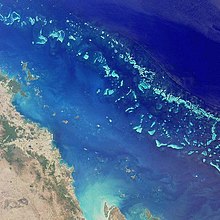
Satellite image of part of the Great Barrier Reef, considered by some measures to be the world's largest living thing.
The Aspen tree (Populus tremuloides) forms large stands of genetically identical trees (technically, stems) connected by a single underground root system. These trees form through root sprouts coming off an original parent tree, though the root system may not remain a single unit in all specimens. The largest known fully-connected Aspen is a grove in Utah nicknamed Pando, and some experts call it the largest organism in the world,[1] by mass or volume.[2] It covers 0.43 km2 (106 acres) and is estimated to weigh 6,600 short tons (6,000 t).[3]
A giant fungus of the species Armillaria solidipes (honey mushrooms) in the Malheur National Forest in Oregon was found to span 8.9 km2 (2,200 acres),[4] which would make it the largest organism by area. Whether or not this is an actual individual organism, however, is disputed: some tests have indicated that they have the same genetic makeup,[5] but unless its mycelia are fully connected, it is a clonal colony of numerous smaller individuals. Another clonal colony that rivals the Armillaria and the Populus colonies in size is a strand of the giant marine plant, Posidonia oceanica, discovered in the Mediterranean near the Balearic Islands. It covers a band roughly 8 km (4.3 miles) in length.[6]
The world's largest single stem tree, by volume, is the General Sherman tree, a Giant Sequoia with a volume of 1,487 m3 (52,500 cu ft).[7] This tree stands 83.8 m (275 ft) tall and the trunk alone is estimated to weigh over 2,000 short tons (1,800 t). The largest single-stem tree ever measured was the Lindsey creek tree, a Coast Redwood with a minimum trunk volume of over 2,500 m3 (88,000 cu ft) and a mass of over 3,600 short tons (3,300 t). It fell over during a storm in 1905.[8]
The largest known animal ever to have existed is the blue whale, an endangered species whose official record length is 33.58 m (110 ft 2 in), and weight 190 short tons (172 metric tons) (for a pregnant female). The largest living land animals by mass are male (bull) African Bush Elephants (Savannah Elephants or Bush Elephants); one known example weighed roughly 27,000 lb (12 t). Some extinct land animals, including many dinosaurs, were much larger still. A 1985 study concluded that the theoretical limit for land-dwelling animals based on known types of body plans was between 100 and 1000 metric tons.[9]
Contents |
Vertebrates
Mammals (Mammalia)
A member of the order Cetacea, the Blue Whale (Balaenoptera musculus) is believed to be the largest animal ever to have lived. The maximum recorded weight was 190 metric tons (210 short tons) for a specimen measuring 30 m (98 ft), while longer ones, up to 33.3 m (109 ft), have been recorded but not weighed.The African Bush Elephant (Loxodonta africana), of the order Proboscidea, is the largest living land animal. At birth it is common for an elephant calf to weigh 100 kg (220 lb). The largest elephant ever recorded was shot in Angola in 1956. It was a male and weighed 24,000 lb (11,000 kg), with an overall length (trunk to tail) of 10 m (33 ft) and a shoulder height of 3.96 m (13.0 ft).[10][11]
- Monotreme mammals (Monotremata)
- The largest extant monotreme (egg-bearing mammal) is the Western Long-beaked Echidna (Zaglossus bruijni) weighing up to 16.5 kg (36.4 lb) and measuring 1 m (3.3 ft) long.[12] The largest monotreme ever was the extinct echidna species Zaglossus hacketti, known only from a few bones found in Western Australia. It was the size of a sheep, weighing probably up to 100 kg (220 lb).
- Marsupials (Marsupialia)
- The Red Kangaroo (Macropus rufus) is the largest living marsupial. The maximum size of these lanky mammals is 100 kg (220 lb) and 1.92 m (6.3 ft) tall.[13] Many much larger marsupials existed prehistorically, the largest of which was Diprotodon. This rhino-sized herbivore would have easily exceeded 2 tonnes (4,400 lb), 3.3 m (11 ft) in length and 1.83 m (6 ft) in height. The Tasmanian Devil (Sarcophilus harrisii) is the largest living carnivorous marsupial. The maximum size of these stocky mammals is 10 kg (22.2 lb) and 91 cm (3 ft) long. The largest ever carnivorous marsupial to exist would have been the Marsupial Lion (Thylacoleo) and the Saber-toothed Marsupial (Thylacosmilus) both ranging from 5 ft (1.5 m) to 6 ft (1.8 m) long and weighing between 100 kg to 160 kg.
- Non-Paenungulate Afrotherians (Afroinsectiphilia)
- The largest species of this clade (which also contains elephant shrews, tenrecs and golden moles) is the Aardvark (Orycteropus afer). Aardvarks are typically up to 1.3 m in length with a weight of up to 65 kg, although individuals as large as 100 kg (220 lb) are recorded.[14]

The African Bush Elephant, the largest living terrestrial animal.
- Even-toed Ungulates (Artiodactyla)
- The largest species in terms of weight is the Hippopotamus (Hippopotamus amphibius), reaching a maximum size of 4,500 kg (10,000 lb), 4.8 m (16 ft) long and 1.66 m (5.5 ft) tall.[15] The longest-bodied species, and tallest of all living land animals, is the Giraffe (Giraffa camelopardalis), measuring up to 5.8 m (19.3 ft), and despite being relatively slender, reaching a top weight of 2,000 kg (4,850 lb).[16] Largest bovids are the Water Buffalo (Bubalis arnee), 400 to 900 kg (880 to 2,000 lb) for the domestic breeds, while the wild animals are nearly 3 m (9.8 ft) long and 2 m (6.6 ft) tall, weighing up to 1,200 kg (2,600 lb) Gaur (Bos gaurus) can all grow to weights of over 900 kg (2,000 lb). American Bison (Bison bison) 6 feet 6 inches (2 m) tall, 10 feet (3 m) long, and weigh 900 to 2,200 pounds (410 to 1,000 kg). As typical in ungulates, the male bison is slightly larger than the female. The biggest specimens on record have weighed as much as 2,500 pounds (1,100 kg). European Bison (Bison bonasus) 3 m (10 ft) long and 1.8 to 2.2 m (6 to 7 ft) tall, and weighs 300 to 920 kg (660 to 2,000 lb).
- Carnivores (Carnivora)
- The largest species is now, with the inclusion of the Pinnipedia, the Southern Elephant Seal (Mirounga leonina) from the Phocidae family. The top size recorded for this species was 5,000 kg (11,000 lb) and 6.9 m (22.5 ft) long. The largest living land carnivores are the Polar Bear (Ursus maritimus) and the Brown Bear (Ursus arctos), both from the Ursidae family and both exceptionally exceeding 1 tonne (2,200 lb), 3 m (10 ft) long, and 1.5 m (5 ft) tall at the shoulder. The extinct subspecies of modern polar bear Ursus maritimus tyrannus may be the largest land carnivore in the order (as well as the largest bear) standing 1.83 m (6 ft 0 in)[17] at the shoulder, 3.7 m (12 ft 2 in) long and with an average weight of 1.2 ton or more. The largest living member of the Felidae family is the Siberian Tiger (Panthera tigris altaica) subspecies, which has an average weight of around 500 lb (230 kg)) for males, but can reach around 600–675 lb (270–310 kg) and weights up to 384 kg (845 lb) are unconfirmed. Even larger were the extinct American Lion (Panthera leo atrox) and the Smilodon populator, a saber-toothed cat. The Liger (Panthera tigris × Panthera leo), the zoo-kept crossbreed of a male Lion and a female Tiger, can reach an obese 798 kg (1,759 lb) or 1,756 lb (797 kg)[citation needed], and a length of 10 ft (3 m). The largest known extant member of canidae is the wolf, though it could be one of two subspecies-either the Mackenzie Valley Wolf (Canis lupus occidentalis), with a record of 79 kilograms (174 lb) or the Eurasian Wolf (Canis lupus lupus), with an unofficial weight of 86 kilograms (190 lb). The largest member of canidae ever is the extinct member of Borophaginae, Epicyon, which has had two different measurements-one at 101 kilograms (224 lb), and one at 85 kilograms (188 lb).
- Whales (Cetacea)
- The largest whale and animal is the aforementioned blue whale, a baleen whale (Mysticeti). Its closest competitor is another baleen whale, the Fin Whale, which can reach 22 m (72 ft) in length. The largest toothed whale (Odontoceti) is the Sperm Whale (Physeter macrocephalus), bulls of which range usually range up to 18 metres (60 ft) and a mass of 50 tonnes (55 short tons), but may possibly grow considerably larger. The Orca or Killer Whale (Orcinus orca) is the largest species of the oceanic dolphin family (Delphinidae). Males normally grow from 6.5–8 m long (20–25 ft) and weigh in excess of 6 tonnes; it has been reported that especially large males have reached nearer 8 tonnes. Females are smaller, growing from 5.7–7 m (18–22 ft) and a weight of about 5 tonnes. The longest Orca ever recorded was a male off the coast of Japan, measuring 9.8 m (32 ft).
- Bats (Chiroptera)
- The largest bat species is the Giant golden-crowned flying fox (Acerodon jubatus), a rare fruit bat and endangered species that is part of the megabat family. The maximum size is believed to approach 1.5 kg (3.3 lb), 55 cm (22 in) long, and the wingspan may be almost 1.8 m (6 ft). The Spectral Bat (Vampyrum spectrum), averaging 168 grams (6 oz), 13.5 cm (5¼ in) and about 80 cm (32 in) in wingspan, is believed to be the largest carnivorous bat, belonging to the microbat family.
- Armadillos (Cingulata)
- The extant giant of this group is the Giant Armadillo (Priodontes maximus). The top size for this species is 32 kg (71 lb) and 89 cm (35 in) in length. Much larger prehistoric examples are known, especially Glyptodon, which easily topped 2.7 m (9 ft) and 2 tonnes (4,400 lb).
- Colugos (Dermoptera)
- Of the two colugo species in the order Dermoptera of gliding arboreal mammals in southeast Asia, the largest and most common is the Sunda Flying Lemur (Cynocephalus varigatus). The maximum size is 2 kg (4.4 lb) and 73 cm (29 in).
- Hedgehogs, gymnures, shrews, and moles (Erinaceomorpha and Soricomorpha)
- The largest of these two orders of small mammals is the Greater Moonrat (Echinosorex gymnura), the maximum size of which is over 2 kg (4.4 lb) and 60 cm (24 in).
- Hyraxes (Hyracoidea)
- The largest species of hyrax seems to be the Cape Hyrax (Procavia capensis), at up to 5.4 kg (12 lb) and 73 cm (29 in) long.
- Rabbits, hares, and pikas (Lagomorpha)
- The largest breed is the Flemish Giant, which is up to 12.7 kg (28 lb), the European Hare (Lepus europaeus), is up to 6.6 kg (14.6 lb) and 76 cm (30 in) long.
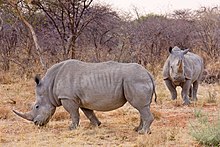
The largest odd-toed ungulates, White Rhinoceros
- Odd-toed Ungulates (Perissodactyla)
- The largest extant species is the White Rhinoceros (Ceratotherium simum). The largest size this species can attain is 4,500 kg (10,000 lb), 4.7 m (15½ ft) long, and 2 m (6½ ft) tall.[18] It is slightly larger than the Indian Rhinoceros (Rhinoceros unicornis). The largest land mammal ever was Paraceratherium or Indricotherium (formerly known as the Baluchitherium), a member of this order. It stood up to 5.5 m (18 ft) tall, measured over 9 m (30 ft) long and may have weighed up to 20 tonnes (22 short tons) though mass estimates vary widely.
- Pangolins (Pholidota)
- The largest species of scaly anteater is the Giant Pangolin (Manis gigantea), at up to 1.7 m (5.8 ft) and at least 40 kg (88 lb).
- Anteaters and sloths (Pilosa)
- The largest species is easily the Giant Anteater (Myrmecophaga tridactyla). A large adult can weigh as much as 65 kg (143 lb) and measure 2.4 m (8 ft) in overall length. The sloths attained much larger sizes prehistorically, the largest of which were Megatherium which, at an estimated average weight of 4.5 tonnes (5 short tons) and height of 5.1 m (17 ft), was about the same size as the African Bush Elephant.

The Eastern Lowland Gorilla is the largest living primate.
- Primates (Primates)
- The Eastern Lowland Gorilla (Gorilla beringei graueri) is the largest living primate. The maximum size of a male gorilla can be over 225 kg (500 lb) and 1.8 m (6 ft) in the wild, with much heavier weights recorded in captivity. Gigantopithecus is the largest known primate ever, probably averaged 3 m (10 ft) tall and weighing 300 to 550 kg (700 to 1,200 lb). It lived from around five million years ago to about 300,000 years ago in the region of India and China.
- Humans (Homo sapiens) can attain massive weights (largest ever documented human, Jon Brower Minnoch, was 636 kg (1,400 lb). However, these are cases of morbid obesity, tumor, and other medical malady. Similarly, humans can attain enormous heights (tallest documented was 8 ft 11 inches (272 cm), Robert Wadlow) due to gigantism. Even when not afflicted with gigantism, humans are the tallest living primates.
- Elephants, mammoths, and mastodons (Proboscidea)
- Most extinct species in the order Proboscidea, such as mammoths and mastodons, did not dwarf the modern African Bush Elephant. The Imperial Mammoth, standing up to 5 m (16 ft) tall, and Deinotherium, which may have surpassed 14 tonnes (15 short tons) are generally considered the largest species. However, recent evidence shows that the largest mammoth ever was the Songhua River Mammoth[citation needed] of China. Mammuthus trogontherii and Deinotherium were also enormous, rivaling the Songhua River Mammoth in size. While African elephants do not normally exceed 7 tonnes in weight, some 'freak' specimens can exceed 12 tonnes, placing the modern African elephant in the list of the largest probiscids ever.
- Rodents (Rodentia)
- The largest living rodent is the capybara (Hydrochoerus hydrochaeris), native to most of the tropical and temperate parts of South America east of the Andes, always near water. Full-grown capybaras can reach a top size of 80 kg (180 lb), 1.5 m (4.9 ft) long, and 90 cm (3.0 ft). The largest known rodent ever is Josephoartigasia monesi, an extinct species known only from fossils. It was approximately 3 metres (10 ft) long and 1.5 metres (5 ft) tall, and is estimated to have weighed around 1 tonne.[19] Prior to the description of J. monesi, the largest known rodent species was Phoberomys insolita. However, this species is known only from very incomplete remains and so its size cannot be estimated with any precision. An almost complete skeleton of its slightly smaller Late Miocene relative Phoberomys pattersoni was discovered in Venezuela in 2000; it was 3 m (10 ft) long, with an additional 1.5 m (5 ft) tail, and probably weighed around 700 kg (1,540 lb).
- Tree Shrews (Scandentia)
- The largest of the tree shrews seems to be the Common Tree Shrew (Tupaia glis), at up to 187 g (6.6 oz) and 40 cm (17 in).
- Dugongs and manatees (Sirenia)
- The largest living species in the order Sirenia of dugongs and manatees is the West Indian Manatee (Trichechus manatus). The maximum size of this species is 1,590 kg (3,500 lb) and 4.1 m (13.5 ft). However, the extinct Steller's Sea Cow (Hydrodamalis gigas) was much larger, growing up to at least 7.9 m (26 ft) long and weighing up to 11 tonnes (12.1 short tons).
Reptiles (Reptilia)

The saltwater crocodile is the largest living reptile.
Extinct crocodilians were sometimes much larger, such as Deinosuchus, at up to 12 m (40 ft) and 9 tonnes (10 tons), Sarcosuchus imperator, also at up to 12 m (40 ft) and 13.6 tonnes (15 tons), and Purussaurus, which was 12 m (40 ft) as well, and Rhamphosuchus, possibly up to 18 m (60 ft) long.
- Lizards & snakes (Squamata)
- The most massive member of this reptilian superorder is the Green Anaconda (Eunectes murinus). The maximum verified size is 5.21 m (18 ft) and 250 kg (550 lb), although rumors of larger anacondas persist. The Reticulated Python (Python reticulatus) is longer but much lighter, and can be up to 8.7 m (28 ft). The largest overall venomous snake is the South American Bushmaster (Lachesis muta), capable of growing 3.65 m (12 ft) long and 8.5 kg (19 lb). The longest venomous snake is the King Cobra (Ophiophagus hannah), with lengths of up to 5.7 m (18.7 ft), but with a weight of 6 kg (13 lb). The heaviest venomous snake on record is a captive Eastern Diamondback Rattlesnake (Crotalus adamanteus), which weighed over 12 kg (26 lb). The largest of the living lizards is the Komodo Dragon (Varanus komodoensis), at a maximum size of 3.13 m (10 ft 3 in) long and 166 kg (366 lb). The largest-ever member of the order was probably one of the giant mosasaurs, such as Hainosaurus, Mosasaurus, or Tylosaurus, all of which grew to around 15 m (50 ft). The largest snake known from the fossil record is Titanoboa, which may have grown to a length of 13 m (42 ft) on average. The prehistoric Megalania prisca (or Varanus priscus) is the largest terrestrial squamate known, but the lack of a complete skeleton has resulted in a wide range of size estimates. Molnar's 2004 assessment resulted in an average weight of 320 kilograms (710 lb), and a maximum of 1,940 kilograms (4,300 lb) at 7 metres (23 ft) in length, which is toward the high end of the early estimates.[22]

The green anaconda is the largest snake.
- Plesiosaurs (Plesiosauria); now extinct
- The largest known plesiosaur was Mauisaurus haasti, growing to around 20 metres in length.
- Ichthyosaurs (Ichthyosauria); now extinct
- The largest of these marine reptiles (extinct for 90 million years) was the species Shonisaurus sikanniensis, at approximately 21 m (70 ft) long.
- Tuataras (Sphenodontia)
- The larger of the two extant species of tuatara is the Brothers Island Tuatara (Sphenodon guntheri). The maximum size is 1.4 kg (3.1 lb) and 76 cm (30 in).
- Turtles (Testudines)
- The largest living turtle is the Leatherback Sea Turtle (Dermochelys coriacea), reaching a maximum length of nearly 2.7 m (9 ft) and a weight of 932 kg (2,050 lb). There are many extinct turtles that vie for the title of the largest ever. The largest seems to be Archelon ischyros, which reached a length of 4.84 m (16 ft) across the flippers and a weight of 2,200 kg (4,500 lb). The Galápagos tortoise and the Aldabra Giant Tortoise can both exceed 300 kg (660 lb) and 130 cm (52 in), and are considered the largest truly terrestrial reptiles alive today. A much larger tortoise survived until about 2000 years ago, Meiolania at about 2.5 m (8½ ft) long and well over a ton.
- Pterosaurs (Pterosauria); now extinct
- A dinosaur-era reptile (although not actually a dinosaur) is believed to have been the largest flying animal that ever existed: the pterosaur Quetzalcoatlus northropi. The maximum size of this soaring giant was believed to have been about 127 kg (280 lb) and 12 m (40 ft) across the wings.[23] Another possible contender for the largest pterosaur is Hatzegopteryx, which is also estimated to have had a 12 m wingspan.[24]
- Dinosaurs (Dinosauria)
See also: dinosaur size

Scale diagram comparing a human and the largest known dinosaurs of the four suborders.

Size comparison of selected giant sauropod dinosaurs. Sauroposeidon (blue), Argentinosaurus (violet), and Amphicoelias fragillimus (red) size estimates are based on fragmentary fossil evidence.
- Now extinct, except for theropod descendants, the Aves.
- Sauropods (Sauropoda)
- Of all the largest dinosaurs, and the largest animals to ever live on land, were the plant-eating Sauropoda. The tallest and heaviest sauropod known from a complete skeleton is the Giraffatitan which was discovered in Tanzania between 1907 and 1912, and is now mounted in the Humboldt Museum of Berlin. It is 12 m (38 ft) tall, and probably weighed between 30,000–60,000 kg (30–65 short tons). The longest is the 25 m (82 ft) long Diplodocus which was discovered in Wyoming, and mounted in Pittsburgh's Carnegie Natural History Museum in 1907.
- There were larger sauropods, but they are known from only a few bones. The current record-holders were all discovered since 1970, and include the massive Argentinosaurus, which may have weighed 80,000–100,000 kg (90 to 110 short tons); the longest, the 35 m (112 ft) long Supersaurus; and the tallest, the 18 m (60 ft) Sauroposeidon, which could have reached into a 6th-floor window. Diplodocus hallorum (formerly known as Seismosaurus) was once thought to have been about 50 m (170 ft) long, making it the longest known vertebrate, but later reconstructions estimate the length at 35 m (115 ft).
- Less well described finds may exceed this. Bruhathkayosaurus may have approached the weight of a Blue Whale, and Amphicoelias fragillimus would have been longer still, at an estimated 60 m (200 ft), but considerably lighter. However, Bruhathkayosaurus is based on very poor material, and the only fossil of Amphicoelias was lost.
-
- Ornithopods (Ornithopoda)
- The very largest ornithopods, like Shantungosaurus were as heavy as medium sized sauropods at up to 23 metric tons (25 short tons) but never grew far beyond 15 meters (50 feet).
- Theropods (Theropoda)
- The longest and heaviest theropod is estimated to be the Spinosaurus, at 16 to 18 metres (52 to 59 ft) long and 7 to 9 tonnes (7.7 to 9.9 short tons) in weight.[25] This is significantly more massive than other contenders such as the Giganotosaurus and Tyrannosaurus. Spinosaurus is notable for having been the largest terrestrial predator known to exist.
- The longest and heaviest theropod known from a complete skeleton is the Tyrannosaurus specimen nicknamed "Sue", which was discovered in South Dakota in 1990 and is now mounted in the Field Museum of Chicago. It is 12.2 m (40 ft) long, and probably weighed 6,800 kg (6.8 metric tons).
- The largest dromaeosaurid is Utahraptor. In addition to being the largest known dromaeosaurid, it was also the largest known deinonychosaur and the largest known paravian.
- Armored Dinosaurs (Thyreophora)
- The longest of the thyreophorans were Ankylosaurus and Stegosaurus, both of which measured up to 9 m in length.
- Cerapods (Cerapoda)
- The largest cerapods were the hadrosaurids Shantungosaurus and "Lambeosaurus" laticaudus. Both species are known from fragmentary remains but are estimated to have reached over 15 m (50 ft) in length[26][27] and weighed over 23 tonnes (50,700 lb).[27]
- Ceratopsians
- The largest ceratopsian was Triceratops. Triceratops is estimated to have reached about 8 m (26 ft) in length[28] and weighed 12 tonnes (26,900 lb).[29] The recently discovered Eotriceratops had a skull estimated to be longer than 3 m, and may have been larger than Triceratops.[30]
Birds (Aves)

The Ostrich is the largest living bird.
The largest bird in the fossil record may be the extinct elephant birds of Madagascar, which were related to the ostrich. They exceeded 3 m (10 ft) and 500 kg (1,120 lb). The last of the elephant birds became extinct about 300 years ago. Of almost exactly the same proportions as the largest elephant birds was Dromornis stirtoni of Australia, part of a 26,000-year old group called mihirungs of the family Dromornithidae. The tallest bird ever however was the Giant Moa (Dinornis maximus), part of the moa family of New Zealand that went extinct about 200 years ago. This moa stood up to 3.7 m (12 ft) tall[31] when it was erected in an unnatural position, but weighed about half as much as a large elephant bird or mihirung due to its comparatively slender frame. The largest carnivorous bird was Brontornis, an extinct flightless bird from South America which reached a weight of 350 to 400 kg (770 to 880 lb) and a height of about 2.8 m (9 ft 2 in).
The largest bird ever capable of flight was Argentavis magnificens, a now extinct member of the Teratornithidae group, with a wingspan of up to 8.3 m (28 ft), a length of over 3 m (10 ft) and a body weight of 80 kg (175 lb).
- Waterfowl (Anseriformes)
- The largest species in general is the Trumpeter Swan (Cygnus buccinator), which can reach an overall length of 1.82 m (6 ft), a wingspan of 3 m (10 ft) and a weight of 17.3 kg (38 lb). However, the heaviest waterfowl ever recorded was an overweight Mute Swan (Cygnus olor) from Poland, who weighed nearly 23 kg (50 lb). The members of the previously mentioned Dromornithidae are now classified as members of this order, making them the largest "waterfowl" that ever lived.
- Swifts & allies (Apodiformes)
- The White-naped Swift (Streptoprocne semicollaris) and the Purple Needletail (Hirundapus celebensis) reach similar large sizes, at up to 225 g (8 oz) and 25 cm (10 in). The hummingbirds are also traditionally included in this order, the largest species of which is easily the Giant Hummingbird (Patagona gigas).
- Nightjars & allies (Caprimulgiformes)
- The largest species of this order is the Great Potoo (Nycitbius grandis), the maximum size of which is about 680 g (1.5 lb) and 60 cm (2 ft).
- Shorebirds (Charadriiformes)
- The largest species in this diverse order is the Great Black-backed Gull (Larus marinus), attaining a size of as much as 85 cm (34 in) and 2.5 kg (5½ lb). The extinct Great Auk (Pinguinus impennis), at 5 kg (11 lb) was the record holder, however.
- Herons & allies (Ciconiiformes)
- The largest species, if measured in regard to body weight and wingspan, is the Andean Condor (Vultur gryphus), reaching a wingspan of 3.2 m (10.7 ft)[31] and a weight of 15 kg (33 lb). The longest-bodied species is probably the Saddle-billed Stork (Ephippiorhynchus senegalensis), which often exceeds 1.5 m (5 ft) tall. Most of the largest flying birds in the fossil record, including the largest, Argentavis magnificens, were members of the Ciconiiformes.
- Mousebirds (Coliiformes)
- The mousebirds are remarkably uniform, but the largest species is seemingly the Speckled Mousebird (Colius striatus), at 2 oz (60 g) and over 14 in (35 cm).
- Pigeons (Columbiformes)
- The largest species of the pigeon/dove complex is the Victoria Crowned Pigeon (Goura victoria). Some exceptionally large ones have reached 3.7 kg (8.2 lb) and 85 cm (34 in). The extinct flightless Dodo (Raphus cucullatus) was the largest bird of this order of all time, weighing about 23 kg (50 lb).
- Kingfishers & allies (Coraciiformes)
- The largest species is the Southern Ground Hornbill (Bucorvus leadbeateri), reaching sizes of as much as 6 kg (13.5 lb) and nearly 1.2 m (4 ft) in length. The Largest kingfisher Giant Kingfisher (Megaceryle maxima) is 42–48 cm long, with a large crest and finely spotted white on black upperparts. The male has a chestnut breast band and otherwise white underparts wit.
- Cuckoos & allies (Cuculiformes)
- The largest species of this order is the Great Blue Turaco (Corythaeola cristata), a cousin of the cuckoos. This species, which can weigh over 1.2 kg and measure over 74 cm in length, is much larger than other turacos. The largest North American cuckoo is Greater Roadrunner (Geococcyx californius) about 56 centimetres (22 in) long and weighs about 300 grams (10.5 oz),

The Eurasian Black Vulture is the biggest of the living birds of prey
- Birds of prey (Falconiformes)
- The largest species is the Eurasian Black Vulture (Aegypius monachus), attaining a maximum size of 14 kg (31 lb), 119 cm (47 in) long and 3 m (10 ft) across the wings. Slightly larger, at up to 1.4 m (4.7 ft) long, wingspan 3 m (10 ft) and weighing at least 15 kg (33 lb), was the now extinct Haast's Eagle (Harpagornis moorei), the largest eagle known.
- Gamebirds (Galliformes)
- The largest member of this diverse order is the Wild Turkey (Meleagris gallopavo). The largest specimen ever recorded was just short of 14 kg (31 lb) and 130 cm (52 in). The heaviest domesticated turkey on record weighed 37 kg (81 lb).[31] The longest species, if measured from the tip of the bill to the end of the long tail coverts, is the Green Peafowl (Pavo muticus), at up to 3 m (10 ft) long. A prehistoric, flightless family, sometimes called (incorrectly) "giant megapodes" (Sylviornis) were the biggest galliformes ever, having reached 1.70 m (5.6 ft) long and weighed up to about 30 kg (66 lb).
- Loons (Gaviiformes)
- The largest species on average is the Yellow-billed Loon (Gavia adamsii), at up to 1 m (3.3 ft) and 7 kg (15.4 lb). However, one exceptional Common Loon (Gavia immer), weighed 8 kg (17.6 lb), heavier than any recorded Yellow-billed Loon.
- Cranes & allies (Gruiformes)
- The Great Bustard (Otis tarda) and Kori Bustard (Ardeotis kori) are the heaviest birds capable of flight, both occasionally reaching 21 kg (46 lb)[31] and 1.5 m (5 ft) long. The tallest and longest bird flying bird on earth, also represented in the Gruiformes, is the Sarus Crane (Grus antigone), sometimes standing almost 2 m (6.6 ft) tall. The largest ever gruiform was a species of "terror bird", highly predatory, flightless birds of South America: Brontornis burmeisteri. This species stood about 2.8 m (9.2 ft) and weigh up to about 400 kg (880 lb).
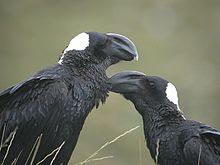
The Thick-billed Raven shares the title of the largest songbird with its common cousin.
- Songbirds (Passeriformes)
- Both the Common Raven (Corvus corax) and the Thick-billed Raven (Corvus crassirostris) are enormous by songbird standards. Both of these birds can exceed 1.5 kg (3.3 lb) and 70 cm (28 in).
- Cormorants & allies (Pelecaniformes)
- The largest species is the Dalmatian Pelican (Pelecanus crispus), which attains a length of 1.82 m (6 ft), a wingspan of 3.5 m (11.5 ft) and a body weight of 15 kg (33 lb). A pelecaniform of the late Miocene, Osteodontornis, was among the largest flying birds ever, at up to 2.1 m (7 ft) long with a wingspan of 6 m (20 ft).
- Flamingos (Phoenicopteriformes)
- The largest flamingo is the Greater Flamingo (Phoenicopterus ruber), at up to 1.5 m (5 ft) tall and 4 kg (8.8 lb).
- Woodpeckers & allies (Piciformes)
- The largest species of this diverse order is the Toco Toucan (Ramphastos toco). The maximum size of this tropical forest bird is possibly as much as 1 kg (2.2 lb) and 75 cm (30 in). The largest woodpecker is the Ivory-billed Woodpecker (Campephilus principalis), which has a total length of about 20 inches (50 centimeters) and, based on very scant information, weighs about 20 ounces (570 grams). It has a 30 inch (75 centimeters) wing span.
- Grebes (Podicipediformes)
- The largest species of grebe is the Great Grebe (Podiceps major). It can reach a length of 80 cm (32 in) and a weigh of over 2 kg (4.4 lb).

The Wandering Albatross are largest sea bird
- Tubenoses (Procellariiformes)
- The largest species is Wandering Albatross (Diomedea exulans), which also possesses longest wingspan of any living bird. The maximum dimensions are a length of 1.44 m (4.6 ft) and a wingspan of 3.63 m (nearly 12 ft).[31] Immature have weighed as much as 13.8 kg (35 lb) at the time of their first flights. The largest-ever tubenose (though it is sometimes classified in the order Pelecaniformes) was the albatross-like Gigantornis eaglesomei, with a wingspan of about 6 m (20 ft).[32]
- Parrots (Psittaciformes)
- The longest and largest overall parrot is the endangered Hyacinth Macaw (Anodorhynchus hyacinthinus), reaching nearly 1.2 m (4 ft) long and 2 kg (4.4 lb). However, the heaviest parrot is the nearly-extinct Kakapo (Strigops habroptila),[33] which can weigh over 4 kg (8.8 lb), but doesn't much exceed 60 cm (2 ft).
- Sandgrouse (Pterocliformes)
- The Black-bellied Sandgrouse (Pterocles orientalis) is the largest sandgrouse, at a maximum size of 634 g (1.4 lb) and 45 cm (18 in).
- Penguins (Sphenisciformes)
- The largest species is easily the Emperor Penguin (Aptenodytes forsteri), with a maximum size of 1.35 m (4.3 ft) and 46 kg (102 lb). At one time, possibly competing with the mammalian pinnipeds, a number of giant penguins existed. The largest is believed to be Anthropornis nordenskjoeldi, having reached a height of 1.7 m (5.6 ft) and a weight of up to 90 kg (200 lb).
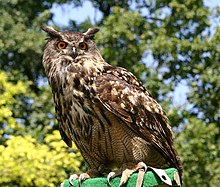
The Eurasian Eagle Owl is one of the biggest owls
- Owls (Strigiformes)
- Both the Eurasian Eagle Owl (Bubo bubo) and Blakiston's Fish Owl (Bubo blakistoni) reach very large sizes. Record-sized specimens of both species have weighed about 4.5 kg (10 lb) and measured over 80 cm (32 in) long. The largest owl known to have existed was Ornimegalonyx oteroi of Cuba, having measured over 1 m (3.3 ft) tall.
- Tinamous (Tinamiformes)
- The largest species of tinamou, a group of chunky, elusive ground-birds from tropical America, is the Grey Tinamou (Tinamus tao). It can reach a weight over 2 kg (4.4 lb) and length of over 55 cm (22 in).
- Trogons (Trogoniformes)
- The Resplendent Quetzal (Pharomachrus mocinno) is much larger than most trogons. It often exceeds 225 g (8 oz) and is at least 35 cm (14 in) along the head-and-body, with the remarkable tail of the male adding 60 cm (2 ft) to the length.
Amphibians (Amphibia)
The largest living amphibian is the Chinese Giant Salamander (Andrias davidianus). The maximum size of this river-dweller is 64 kg (140 lb) and 1.83 m (6 ft). Before amniotes became the dominant tetrapods, several giant amphibian-like tetrapods existed. The largest known was the crocodile-like Prionosuchus, which reached a length of 9 m (30 ft).- Frogs (Anura)
- Easily the largest member of the largest order of amphibians is the African Goliath frog (Conraua goliath). The maximum size of this species is a weight of 3.8 kg (8.4 lb) and a snout-to-vent length of 35 cm (14 in). The largest of the toads is the Cane Toad. However, the extinct Beelzebufo ampinga could grow to be 40 cm (16 in) long and weigh up to 4.5 kg (10 lb). The largest tree frog is the White-lipped Tree Frog (Litoria infrafrenata), the females of which can reach a length of 13 cm from snout to vent. The largest horned or "Pacman frog" is the Surinam horned frog (Ceratophrys cornuta), which can reach 20 cm in length from snout to vent. The largest dendrobatid is the Columbian Golden Poison Frog, which can attain a length of 6 cm when fully grown.
- Caecilian (Gymnophiana)
- The largest of the worm-like caecilians is the Thomson's Caecilian (Caecilia thompsoni), which reaches a length of 1.5 m (5 ft) and can weigh up to about 1 kg (2.2 lb).
Ray-finned bony fish (Actinopterygii)
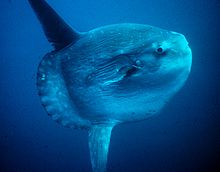
The ocean sunfish is the largest of the bony fish
- Sturgeons (Acipenseriformes)
- The largest species is the huge beluga sturgeon (Huso huso). The maximum recorded size of this endangered species is nearly 7.9 m (26 ft) and 2,075 kg (4,565 lb). The Kaluga or Great Siberian Sturgeon has been recorded at 1000 kg (2200 lb), making it the largest known freshwater fish.
- Eels (Anguilliformes)
- The largest species, if measured in weight and overall bulk, is the European conger (Conger conger). The maximum size of this species is 2.87 m (9.5 ft) and 60.6 kg (133¼ lb).[34] Getting slightly longer, at up to 4 m, is the Slender giant moray (Strophidon sathete).[35]
- Minnows & allies (Atheriniformes)
- An order best known for its small minnow representatives, the largest species is the jacksmelt (Atherinopsis californiensis). Although it reaches 45 cm (18 in), it is not known to even reach 450 g (1 lb).
- Grinners (Aulopiformes)
- The largest member of this order is the lancetfish (Alepisaurus ferox). Slender, with a huge, dramatic spine, these fish can reach 5.4 kg (12 lb) and 2.1 m (7 ft).
- Toadfish (Batrachoidiformes)

The largest toadfish, the Pacuma toadfish.
- The largest toadfish is the Pacuma toadfish (Batrachoides surinamensis), reaching a size of up to 5 lb (2.3 kg) and 23 in (58 cm).
- Flying-fish & allies (Beloniformes)
- The largest member of this order, best known for its members' ability to breach the water and zip through the sky, is the Agujon needlefish (Tylosurus acus), a slender fish at up to 1.5 m (5 ft) and a weight of 3.7 kg (8.2 lb).
- Squirrelfish (Beryciformes)
- Best known for their highly poisonous barbs, the squirrelfish's largest representative is the giant squirrelfish (Sargocentron spiniferum), at up to 60 cm (24 in) and 3.5 kg (7.7 lb).
- Characins (Characiformes)
- The largest species is the giant tigerfish (Hydrocynus goliath). The top size of this fish is 1.5 m (5 ft) and 44 kg (97 lb).[36]
- Herring (Clupeiformes)
- The largest herring is probably the Dorab wolf herring (Chirocentrus dorab). The maximum size of this species has been reported as much as 1.8 m (6 ft), but these slender fish have never been recorded as exceeding 3.4 kg (7.5 lb) in weight.
- Carp (Cypriniformes)
- The largest species today is probably the giant barb (Catlocarpio siamensis), which reaches a size of as much as 3 m (10 ft) and a weight of as much as 300 kg (660 lb). In centuries past, the Mahseer (Barbus tor) was reported to reach similar or even larger proportions, but large specimens are quite rare recently.
- Killifish & allies (Cyprinodontiformes)
- The largest species is the Pacific four-eyed fish (Anableps dowei), reaching a size of 33 cm (13 in) and 588 g (1 lb 4¾ oz).
- Cod (Gadiformes)

The largest cod, the Atlantic cod.
- The largest cod species, although it rarely reaches large sizes anymore due to heavy fishing, is the Atlantic cod (Gadus morhua). The maximum recorded size of this species is 2 m (6.7 ft) long and 96 kg (212 lb).
- Shellears & allies (Gonorynchiformes)
- The well-known milkfish (Chanos chanos) is the largest member of this order. The maximum size is 22.7 kg (50 lb) and 1.84 m (6.1 ft) long.
- Ribbonfish & allies (Lampriformes)

The largest ribbonfish, the King of herrings.
- The largest member of this small but fascinating order is the King of herrings (Regalecus glesne), also the longest bony fish on earth. Slender and compressed, this fish averages over 6 m (20 ft) long and can weigh 275 kg (605 lb). One fish was 11.3 m (37.3 ft) long, but there is a possibility that the oarfish reaches 16 m (55 ft).
- Gars (Lepisosteiformes)
- The largest of the gar, and the largest entirely freshwater fish in North America, is the alligator gar, Atractosteus spatula, reaching a size of 3 m (10 ft) and 127 kg (279 lb).[36]
- Anglerfish (Lophiiformes)
- The largest of this diverse order is the common goosefish (Lophius piscatorius). This big-mouthed fish can attain a size of 58 kg (127 lb) and a length of 1.9 m (6.2 ft).
- Lanternfish (Myctophiformes)
- The largest of the numerous but small lanternfish is Bolin's lanternfish (Gymnoscopelus bolini), at up to 249 g (8.8 oz) and 35 cm (14 in).
- Pearlfish & allies (Ophidiiformes)
- The largest member of this order is the giant cuskeel (Lamprogrammus shcherbachevi). A cuskeel can be nearly 2 m (6.7 ft) long, but even large fish probably aren't much over 10 kg (22 lb) since they are quite slender.
- Bony-tongued fish (Osteoglossiformes)
- The largest species is the South American fish usually known as the arapaima, Arampaima gigas. This laterally compressed fish can reach a size of about 3 m and a weight of 202 kg (455 lb).
- Perches & allies (Perciformes)
- The title of the largest member of this order, the most numerous order of all vertebrates, is a matter of some debate. A large marlin is the biggest of these fishes, as they are known to exceed even the huge northern bluefin tuna, Thunnus thynnus, in size. The black marlin, Makaira indica, the Atlantic blue marlin, Makaira nigricans, and the Indo-Pacific blue marlin, Makaira mazara, all reach similar large sizes, at up to 900 kg (2,000 lb) and 4.7 m (15.5 ft).
- Flatfish (Pleuronectiformes)
- The largest of the well-known and heavily-fished flatfish is the Pacific halibut, Hippoglossus stenolepis. This giant can reach 363 kg (800 lb) and 2.67 m (8.8 ft), although fish even approaching this size would be extraordinary these days.
- Salmon & allies (Salmoniformes)
- The largest species of salmon is the Chinook salmon, Oncorhynchus tshawytscha. The maximum size of this fish is 61.4 kg (135 lb) and 1.5 m (5 ft) long. The taimen is the largest salmonid in the world. The maximum size is not well known, but a fish caught in the Kotui River in Russia with a length of 210 cm (83 in) and a weight of 105 kg (231 lb) is the largest reliable record[37].
- Sculpins (Scorpaeniformes)
- Although less venomous than many smaller fish in the same order, the skilfish, Erilepis zonifer, is largest sculpin. The maximum size is 1.9 m (6.2 ft) and the weight can be 90 kg (200 lb).
- Catfish (Siluriformes)
- Most authorities now give the crown of the largest catfish to the Mekong giant catfish, Pangasianodon gigas. This huge fish has been recorded at a size of over 2.7 m (9 ft) and a weight of 293 kg (646 lb).[38][39][40] However, the wels catfish, Silurus glanis, may possibly be longer. The largest wels scientifically recorded was 3 m (10 ft) and 220 kg (484 lb).
The Largest bristlemouth, the Short-tailed barbeled dragonfish
- Bristlemouths (Stomiiformes)
- The largest of the bristlemouths is the short-tailed barbeled dragonfish, Oppostomias micripnus. The top size of a female of this species is probably over 452 g (1 lb) and 50 cm (20 in) long.
- Seahorses & allies (Syngnathiformes)
- The largest of this diverse order is the red cornetfish, Fistularia petimba, reaching a length of 2 m (6.6 ft) and weight of over 4.5 kg (10 lb).
- Dories (Zeiformes)
- The largest species of dory is the Cape dory, Zeus capensis, reaching a size of 90 cm (36 in) and a weight of 20 kg (44 lb).
Cartilaginous fish (Chondrichthyes)

A size comparison of a whale shark and a human.
- Ground sharks (Carcharhiniformes)
- The largest species of this order is the tiger shark, Galeocerdo cuvier. This species can attain a weight of 635 kg (1,400 lb) and length of possibly as much as 6.4 m (21 ft).
- Mackerel sharks (Lamniformes)
- The largest living species is the basking shark, Cetorhinus maximus, also the second largest fish. The maximum, verified size for this shark is 12.4 m (41 ft) and weight is 16 tonnes (17.6 short tons). An even larger shark, generally regarded as the largest macro-predatory fish ever, is the C. megalodon, an ancient relative of the great white shark. This giant shark reached a total length (TL) of more than 16 metres (52 ft).[41][42] C. megalodon may have approached a maxima of 20.3 metres (67 ft) in total length and 103 metric tons (114 short tons) in mass.[43]
- Stingrays & allies (Myliobatiformes)
- Both the largest species of this order and the largest of the rays is the manta ray, Manta birostris. This peaceful leviathan can reach a size of 3 tonnes (3.3 short tons), a "disk" width of 7.6 m (25 ft) and a length of 5 m (16.5 ft).
- Sawfish (Pristiniformes)
- These little known cartilaginous fish can often reach huge sizes. The largest bulk recorded for a sawfish is for the southern sawfish, Pristis perotteti, which weighed 2.4 tonnes (2.7 short tons). At this weight, the sawfish must have measured nearly 9 m (30 ft).
- Skates (Rajiformes)
- The largest and most diverse order of rays' largest species is the giant guitarfish, Rhynchobatus djiddensis. The top size of the species is 250 kg (550 lb) and 3.1 m (10.2 ft).
- Dogfish (Squaliformes)
- The largest member of this order is the Greenland shark, Somniosus microcephalus. This species probably reaches 7.2 m (24 ft) and large specimens weigh over 1,364 kg (3,000 lb).
- Angelsharks (Squatiniformes)
- The largest of the bottom-dwelling angelsharks is the Angelshark, Squatina squatina, attaining a size of 100 kg (220 lb) and 2.42 m (8 ft).
Mammal-like reptiles (Synapsida)
Cotylorhynchus probably was the largest of all synapsids (which went extinct several million years ago), at 20 feet (6 meters) and 2 tons. The largest carnivorous synapsid was Anteosaurus, which was 5–6 meters long, and weighed 500–600 kg.- Pelycosauria
- The largest Pelycosaur was the pre-mentioned Cotylorhynchus (20 feet, 2 tons), and the largest predatory pelycosaurus was Ivantosaurus, with a length of 20 feet (6 meters).
- Therapsida
- Moschops was the largest Therapsid, with a weight of 700–1000 kg, and a length of about 5 meters. The largest carnivorous Therapsid was Anteosaurus, which was 5-6 meters long, and weighed 500-600 kg.
Table of heaviest terrestrial animals
The following is a list of the heaviest land animals. The walrus and the saltwater crocodile are included as they spend much of their time on land. The African Elephant is not split into its possible separate species of the African Bush Elephant and African Forest Elephant as it is not yet a fully accepted split.| Rank | Animal | Average Mass (kg) | Maximum Mass (kg) | Average Length (m) |
|---|---|---|---|---|
| 1 | African Elephant[44] | 8260 (18,500 lbs) | 12,050 (27,000 lbs) | 6.56 (21.85 ft) |
| 2 | Asian Elephant[45] | 3910 (8,750 lbs) | 4900 (11,000 lbs) | 5.85 (19.5 ft) |
| 3 | Hippopotamus | 2340 (5,250 lbs) | 4400 (8,000 lbs) | 3.3 (11 ft) |
| 4 | White Rhinoceros | 2230 (5,000 lbs) | 3540 (7,920 lbs) | 3.75 (12.5 ft) |
| 5 | Gaur | 1470 (3,300 lbs) | 1995 (4400 lbs) | 2.94 (9.8 ft) |
| 6 | Giraffe | 1340 (3,000 lbs) | 1960 (4,400 lbs) | 4.62 (15.4 ft) |
| 7 | Walrus | 1180 (2,645 lbs) | 2010 (4,500 lbs) | 3.3 (11 ft) |
| 8 | Black Rhinoceros | 1080 (2,420 lbs) | 1790 (4,000 lbs) | 3.38 (11.25 ft) |
| 9 | Saltwater crocodile | 760 (1,700 lbs) | 1470 (3,300 lbs) | 6 (20 ft) |
| 10 | Wild Asian Water buffalo | 748 (1,684 lbs) | 1180 (2,640 lbs) | 3.42 (11.4 ft) |
Invertebrates
Sponges (Porifera)
Arguably the most primitive form of animals in existence, the largest species of sponge is the giant barrel sponge, Xestospongia muta. These massively-built sponges can reach 8 feet (2.4 m) in height and can be of about the same number of feet across at the thickest part of the "body".- Calcareous sponges (Calcarea)
- The largest of these small, inconspicuous sponges is probably the species Pericharax heteroraphis, attaining a height of 30 cm (1 ft). Most calcareous sponges do not exceed 10 cm (4 in) tall.
- Hexactinellid sponges (Hexactinellida)
- A relatively common species, Rhabdocalyptus dawsoni, can reach a height of 1 m (3.3 ft) once they are of a very old age. This is the maximum size recorded for a hexactinellid sponge.
Cnidarians (Cnidaria)
The Lion's mane jellyfish is the largest cnidaria species, of the class Scyphozoa. The largest known specimen of this giant, found washed up on the shore of Massachusetts Bay in 1870,[46][47][48] had a bell diameter of 2.5 m (8 ft), a weight of 150 kg (330 lb) and possessed tentacles as long as 40 m (120 ft) making it one of the longest extant animals.- Corals and sea-anemones (Anthozoa)
- The largest individual species are the sea-anemones of the genus Discoma, which can attain a mouth disc diameter of 60 cm (2 ft). Longer, but much less massive overall, are the anemones of the genus Ceriantharia, at up to 2 m (6.6 ft) tall. Communities of coral can be truly massive, a single colony of the Porites genus can be over 10 m (33 ft), but the actual individual organisms are quite small.
- Box jellyfish (Cubozoa)
- The largest of the box jellyfish is the species Chironex fleckeri, which can attain a mass of 6 kg (13 lb), a 30 cm (1 ft) bell and a tentacle length up to 2 m (6.6 ft). This species is also the most common and dangerous box jelly.
- Hydrozoans (Hydrozoa)
- The colonial siphonophore Praya dubia can attain lengths of 40–50 m :(130–160 ft).
Flatworms (Platyhelminthes)
The largest terrestrial species of this phylum of mostly parasites, called flatworms in common language, is the greenhouse planarian, Bipalium kewense, of the class Turbellaria. This planarian can reach a length of 60 cm (2 ft) and is quite massive for a flatworm.- Monogenean flatworms (Monogenea)
- The largest members of this group of very small parasites are among the genus of capsalids, Listrocephalos, reaching a length of 2 cm (0.8 in).
- Flukes (Trematoda)
- The largest species of fluke is Fasciolopsis buski, which most often attacks humans and livestock. One of these flukes can be up to 7.5 cm (3 in) long and 2 cm (¾ in) thick.
- Tapeworms (Cestoda)
- The largest species of tapeworm is commonly called the fish tapeworm, Diphyllobothrium latum, since they are commonly contracted from eating fish. This devastating parasite has been recorded as reaching a length of 20 m (66 ft) in the internal organs of a human, and a length of 30 m in other hosts.[citation needed]
Roundworms (Nematoda)
The largest roundworm, Placentonema gigantissima,[49] is a parasite found in the placentas of sperm whales which can reach up to 30 ft (9 m) in length.Segmented worms (Annelida)
The largest of the segmented worms is the African giant earthworm, Microchaetus rappi. This huge worm can reach a length of as much as 6.7 m (22 ft)[50] and can weigh over 1.5 kg (3.1 lb). Only the giant Gippsland earthworm, Megascolides australis, and a few giant polychaetes reach nearly comparable sizes, reaching 4 m (13 ft) and 3.6 m (11.9 ft), respectively.Echinoderms (Echinodermata)
The largest species of echinoderm in terms of bulk is the sea star species Thromidia catalai, of the class Asteroidea, which reaches a weight of over 6 kg (13 lb). However, at a maximum span of 63 cm (25 in), it is quite a bit shorter than some other echinoderms. The longest-bodied echinoderm is the brisingid sea star Midgardia xandaros, reaching a span of 1.4 m (4.5 ft), despite being quite slender.- Crinoids (Crinoidea)
- The largest species of crinoid is the unstalked feather-star, Heliometra glacialis, reaching a total width of 78 cm (31 in) and an individual arm length of 35 cm (14 in). In the past, crinoids grew much larger, and stalk lengths up to 40 m (130 ft) have been found in the fossil record.[51]
- Sea-urchins & allies (Echinoidea)
- The largest sea urchin is the species Sperosoma giganteum, which can reach a shell width of 33 cm (13 in).
- Sea-cucumbers (Holothuroidea)
- The bulkiest species of sea cucumber is Stichopus variegatus, weighing several pounds, being about 21 cm (8.3 in) in diameter, and reaching a length of 1 m (3.3 ft) when fully extended. Species of sea cucumber in the genus Synapta can reach an extended length of 2 m (6.6 ft), but are extremely slender.
- Brittle stars (Ophiuroidea)
- The largest known specimen of brittle star is Gorgonocephalus stimpsoni. This species can measure 70 cm (28 in) in arm length and has a disk diameter of about 14.3 cm (5.63 in).
Ribbon worms (Nemertea)
The largest nemertean and possibly the longest animal is the bootlace worm, Lineus longissimus. A specimen found washed ashore on a beach in St. Andrews, Scotland in 1864 was recorded at a length of 55 m (180 ft).[52]Molluscs (Mollusca)

A 7 m (23 ft) Giant Squid, the second largest of all invertebrates, encased in ice in the Melbourne Aquarium.
The Giant Squid (Architeuthis dux) was previously thought to be the largest squid, and while it is less massive and has a smaller mantle than the Colossal Squid, it may exceed the colossal squid in overall length including tentacles. The giant squid can measure up to 13 m (43 ft) or more from tentacle tip to tail tip, or 2.25 m (7.4 ft) in mantle length, and can weigh up to 275 kg (600 lb).[54]
- Aplacophorans (Aplacophora)
- The largest of these worm-like, shell-less mollusks are represented in the genus Epimenia, which can reach 30 cm (12 in) long. Most aplacophorans are less than 5 cm (2 in) long.
- Chitons (Polyplacophora)
- The largest of the chitons is the gumboot chiton, Cryptochiton stelleri, which can reach a length of 33 cm (13 in).
- Bivalves (Bivalvia)
- The largest of the bivalve mollusks is the giant clam, Tridacna gigas. Although even more enormous sizes have been reported for this monstrous but passive animal, the top verified size is 600 lb (270 kg), 3 ft 10 (1.17 m) in length and 30 in (0.76 m) wide. The largest bivalve ever was Platyceramus platinus, a Cretaceous giant that reached an axial length of up to 3 m (nearly 10 ft).[55]
- Gastropods (Gastropoda)
- The "largest" of this most diverse and successful mollusk class of slugs and snails can be defined in various ways.
- The living gastropod species that has the largest (longest) shell is Syrinx aruanus, maximum length of shell, 91 cm. Also supposedly reaches a size of 16.4 kg (36 lb), a length of 70 cm (28 in) and a width of 96 cm (38 in).
- The largest shell-less gastropod is the giant black sea hare Aplysia vaccaria at 99 cm in length and almost 14 kg in weight.
- The largest of the land snails is the Giant African snail, Achatina achatina, at up to 1 kg (2.2 lb) and 35 cm (14 in) long.
- Cephalopods (Cephalopoda)
- (See Cephalopod size.) While generally much smaller than the giant Architeuthis and Mesonychoteuthis, the largest of the octopuses, the North Pacific Giant Octopus, Enteroctopus dofleini, can be very large. The largest confirmed weight of a giant octopus is 71 kg,[56] with a 7-metre (23 ft) arm span.[57]
Arthropods (Arthropoda)
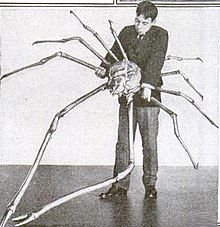
In terms of overall size, the Japanese spider crab is the largest of all arthropods.
However, the American lobster, Homarus americanus, another crustacean and the largest member of Astacidea (lobsters and crayfish), rivals the Japanese spider crab in mass, if not dimension. This lobster has been recorded at heavier weights, up to 22 kg (48.4 lb), and can measure 1.18 m (3.9 ft) along the body.
The coconut crab, Birgus latro, also a crustacean, is the largest land arthropod and the largest land invertebrate, up to 40 cm (1.3 ft) long and weighing up to 4 kg (8.8 lb). Its legs may span 1 m (3.25 ft).
The largest arthropod ever known to exist was either the eurypterid (sea scorpion) Jaekelopterus or the Carboniferous millipede Arthropleura, which were both between 2.5 and 2.6 m (8.2-8.5 ft) in length [2]. They were closely followed by Pterygotus, an aquatic eurypterid that was up to 2.3 m (7.5 ft) in length. The closest living relatives of Eurypterida are the arachnids, horseshoe crabs, and sea spiders.

The Giant huntsman spider was considered in the December 2008 WWF report as "the world's largest Huntsman spider."[58]
- Arachnids (Arachnida)
- The largest species of arachnid is probably the Goliath birdeater, Theraphosa blondi. However, of very comparable dimensions and possibly even greater mass, are the Chaco golden knee, Grammostola pulchripes, and the Brazilian salmon pink, Lasiodora parahybana. Some of these huge New World "tarantulas" have been recorded as reaching a leg span of 28 cm (11 in), a body length over 9 cm (3.5 in) and a body weight exceeding 85 g (3 oz). The largest of the scorpions is the species Heterometrus swammerdami, which can reach 29 cm (11.5 in) long and a weight of up to 57 g (2 oz). However, they were dwarfed by Pulmonoscorpius kirktonensis, a giant extinct species of scorpion from Scotland and the aquatic Brontoscorpio.
- Branchiopods (Branchiopoda)
- The largest of these primarily freshwater crustaceans is probably Branchinecta gigas, which can reach a length 10 cm (3.9 in).
- Centipedes (Chilopoda)
- The biggest of the centipedes is the Scolopendra gigantea, reaching a relatively enormous length of 33 cm (13 in).
- Millipedes (Diplopoda)
- Two species of millipede both reach a very large size Archispirostreptus gigas and Scaphistostreptus seychellarum. Both of these species can slightly exceed a length of 28 cm (11 in). The 300-million year old Arthropleura, either a primitive millipede or a close relative, was the largest land invertebrate ever, having measured at least 2.5 m (8.2 ft) long and 45 cm (18 in) wide.
- Barnacles & allies (Maxillopoda)
- The largest species is a copepod (Pennella balaenopterae), known exclusively as a parasite from the backs of Fin Whales (Balaenoptera physalus). The maximum size attained is 32 cm (about 13 in). The largest of the barnacles is the giant acorn barnacle, Balanus nubilis, reaching 7 cm (2.8 in) in diameter and 12.7 cm (5 in) high.
- Horseshoe crabs (Merostomata)
- The four modern horseshoe crabs are of roughly the same sizes, at up to 60 cm (2 ft) in length. Easily the best known species is Limulus polyphemus of North America.
- Ostracods (Ostracoda)
- The largest of these small and little-known but numerous crustaceans is the species Gigantocypris agassizii, reaching a maximum length of 3 cm (1.3 in).
- Amphipods, Isopods, and allies (Peracarida)
- The largest species is the giant isopod, which can reach a length of 45 cm (18 inches) and a weight of 1.7 kg (3.7 lb).
- Sea spiders (Pycnogonida)
- The largest of the sea spiders is the deep-sea species Colossendeis colossea, attaining a leg span of nearly 60 cm (2 ft).
- Remipedes (Remipedia)
- The largest of these cave-dwelling crustaceans is the species Godzillius robustus, at up to 4.5 cm (1.8 in).
- Trilobites (Trilobita)
- Some of these extinct marine arthropods exceeded 60 cm (24 inches) in length. A nearly complete specimen of Isotelus rex from Manitoba attained a length over 70 cm (27 in), and a Ogyginus forteyi from Portugal was almost as long. Fragments of trilobites suggest even larger record sizes. An isolated pygidium of Hungioides bohemicus implies that the full animal was 90 cm (36 in) long.[59][60]
Insects (Insecta)
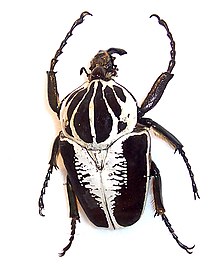
The goliath beetle is arguably the world's heaviest insect
The longest insects are the stick insects, see below.
Representatives of the extinct dragonfly-like order Protodonata such as the Carboniferous Meganeura monyi and the Permian Meganeuropsis permiana are the largest insect species ever known. These creatures had a wingspan of some 75 cm (30 in) and a body weight of over 1 lb (450 g)[citation needed], making them about the size of a crow.
- Cockroaches (Blattodea)
- The largest cockroach is the giant burrowing cockroach (Macropanesthia rhinoceros). This species can attain a length of 8.3 cm (3.3 in) and a weight of 36 g (1.3 oz).
- Beetles (Coleoptera)
- The beetles are the largest order of organisms on earth, with about 350,000 species so far identified. The most massive species are the Goliathus, Megasoma and Titanus beetles already mentioned. The longest species is the Hercules beetle, Dynastes hercules with a maximum overall length of at least 17 cm (7 in) including the very long pronotal horn.
- Earwigs (Dermaptera)
- The largest of the earwigs is the Saint Helena giant earwig, Labidura herculeana, which is up to 8.4 cm (3¼ in) in length[citation needed].
- True flies (Diptera)
- The largest species of this huge order is the species Gauromydas heros, which can reach a length of 6 cm (2½ in) and a wingspan of 10 cm (4 in). Species of crane fly, the largest of which is Holorusia brobdignagius, can attain a length of 23 cm (9 in) but are extremely slender and much lighter in weight than Mydas.
- Mayflies (Ephemeroptera)
- The largest mayflies are members of the genus Proboscidoplocia from Madagascar. These insects can reach a length of 5 cm (2 in).
- True bugs (Hemiptera)
- The largest species of this diverse, huge order is a giant water bug, Lethocerus maximus. This species can attain a length of 11.6 cm (4.6 in), although it is more slender and less heavy than most other insects of this size (principally the huge beetles).
- Ants & allies (Hymenoptera)
- The largest of the ants, and the heaviest species of the order, are the females of Dorylus helvolus, reaching a length of 5 cm (2 in). The ant that averages the largest for the mean size of the whole colony is Dinoponera gigantea, averaging up to 3.3 cm (1¼ in). The largest of the bee species, also in the order Hymenoptera, is Megachile pluto, the females of which can be 3.8 cm (1½ in) long, with a 6.3 cm (2½ in) wingspan. The largest wasp is probably the so-called tarantula hawk species Pepsis pulszkyi, at up to 6.8 cm (2¾ in) long and 11.6 cm (4½ in) wingspan, although many other Pepsis approach a similar size.
- Termites (Isoptera)
- The largest of the termites is the African species Macrotermes bellicosus. The queen of this species can attain a length of 10.6 cm (4.2 in) and breadth of 5.5 cm (2¼ in); other adults, on the other hand, are about a third of the size.

The Queen Alexandra's birdwing is the largest species of butterfly.
- Moths & allies (Lepidoptera)
- The largest species is probably either the Queen Alexandra's birdwing, Ornithoptera alexandrae, a butterfly, or the Atlas moth, Attacus atlas, a moth. Both of these species can exceed a length of 8 cm (3¼ in), a wingspan of 28 cm (11 in) and a weight of 12 g. Their larvae can weigh up to 58 g (2.0 oz) or 1.9 oz (54 g) . However, the White Witch, Thysania agrippina, has the longest recorded wingspan of the order, and indeed of any living insect, at up to at least 30 cm (12 in), though it is exceeded in surface area and mass by both Ornithoptera and Attacus.
- Praying mantises (Mantodea)
- The largest species of this order is the Chinese mantis, Tenodera aridifolia. The females of this species can attain a length of up to 10.6 cm (4.2 in).
- Dragonflies (Odonata)
- The largest living species of dragonfly is Megaloprepus caerulatus, attaining a size of as much as 19 cm (7.5 in) across the wings and a body length of over 12 cm (4.7 in). The largest species of dragonfly ever is the extinct Meganeura.
- Grasshoppers & allies (Orthoptera)
- The largest of this widespread, varied complex of insects is the giant weta, Deinacrida heteracantha, of New Zealand. This formidable insect can weigh over 75 g (2.6 oz) and measure up to nearly 10 cm (4 in), rivaling the huge beetles in size. The largest grasshopper species is Valanga irregularis, which can be up to 3.5 inches in length.
- Stick insects (Phasmatodea)
- The longest known stick insect is Phobaeticus chani, with one specimen held in the Natural History Museum in London measuring 567 millimetres (22.3 in) in total length.[63] This measurement is, however, with the front legs fully extended. The body alone still measures 357 millimetres (14.1 in).[64] The species with the second longest body is Phobaeticus kirbyi, which measures up to 328 millimetres (12.9 in),[65] while the overall length (from the hind to the front legs) is up to 546 millimetres (21.5 in),[65] and the body weight is up to 72 g (2.5 oz).[citation needed] The second longest insect in terms of total length is Phobaeticus serratipes, measuring up to 555 millimetres (21.9 in).[66]
- Stoneflies (Plecoptera)
- The largest species of stonefly is Pteronarcys californica, a species favored by fishermen as lures. This species can attain a length of 5 cm (2 in) and a wingspan of nearly 7.5 cm (3 in).
- Booklice (Psocoptera)
- The largest of this order of very small insects are the barklouse of the genus Psocus, the top size of which is about 1 cm (0.4 in).
- Fleas (Siphonaptera)
- The largest species of flea is Hystrichopsylla schefferi. This parasite is known exclusively from the fur of the Mountain Beaver and can reach a length of 1.2 cm (0.5 in).
- Thrips (Thysanoptera)
- Members of the genus Phasmothrips are the largest kinds of thrips. The maximum size of these species is approximately 1.3 cm (0.5 in).
Plants
The largest single-stem plants are all members of the conifer division. By volume and mass, the largest tree is the Giant Sequoia (Sequoiadendron giganteum). They grow to an average height of 70–85 m (230–280 ft) and 5–7 m (16–23 ft) in diameter. Specimens have been recorded to be up to 94.9 m (307 ft) in height and (not the same individual) 8.98 m (29 ft) in diameter; the largest individual is the General Sherman tree, with a volume of 1,489 m3 (52,600 ft3).[67] Although not so large in volume, the closely related Coast Redwood (Sequoia sempervirens) is taller, reaching a maximum height of 115.55 m (379.1 ft).[68] These trees dwarf any other non-communal organism, as even the largest Blue Whales are likely to weigh one-sixteenth as much as a large Giant Sequoia or Coast Redwood. See record trees for other tree records.- Algae
- The largest form of algae is the huge form of seaweed from the northwestern Pacific known as the giant kelp (Macrocystis pyrifera). The record-sized stem from one of these just slightly exceeded 60 m (200 ft).[citation needed]
- Liverworts (Marchantiophyta)
- The largest species of liverwort is a New Zealand species, Schistochila appendiculata. The top size of this species is 1.1 m (3.6 ft) long, a diameter of 2.5 cm (1 in) and a stem length of 10 cm (4 in).[citation needed]
- Mosses (Bryophyta)
- The world's largest moss is Dawsonia superba, of New Zealand. This species can be 50 cm (20 in) tall.[69]
- Horsetails (Equisetophyta)
- The largest of horsetail is the species Equisetum myriochaetum, of central Mexico. The biggest specimen known was 8 m (26.4 ft) tall and had a diameter of 2.5 cm (1 in).[citation needed]
- Ferns (Pteridophyta)
- The largest species of fern is probably Cyathea brownii of Norfolk Island, which may be 20 m (66 ft) or more in height.[70]
- Conifers (Pinophyta)
- Besides the giant Sequoiadendron and Sequoia already mentioned, the conifers also include the largest tree by circumference in the world, the Montezuma Cypress (Taxodium mucronatum). The thickest recorded tree, found in Mexico, is called Árbol del Tule, with a circumference of 35.87 m (118.3 ft) and a diameter of 11.42 m (37.5 ft) at 1.5 m (5 ft) above ground level.[citation needed]
- Cycads (Cycadophyta)
- The largest species of cycad is Hope's Cycad (Lepidozamia hopei), of the Queensland area of Australia. The largest examples of this species have been over 17 m (56 ft) tall and have had a diameter of over 50 cm (20 in).[citation needed]

Rafflesia arnoldii flower
- Flowering plants (Magnoliophyta)
- This is the most diverse and numerous division of plants, with upwards of 400,000 species. Typically the largest flowering plant (angiosperm) has been considered Eucalyptus regnans, which can reach heights of 99.6 m (327 ft).[71]
- Stands of trees connected to a single root system (a single organism genetically) may be considered the largest organisms, and the largest flowering plants. The largest known such colony is a male Aspen in Utah, nicknamed Pando (Populus tremuloides), which is estimated to weigh in at approximately 6,000 tonnes (6,615 tons).[1]
- Another form of flowering plant that rivals Pando as the largest organism on earth in breadth, if not mass, is the giant marine plant, Posidonia oceanica, discovered in the Mediterranean near the Balearic Islands, Spain. Its length is about 8 km (4.3 mi). Although this plant has not been proven to be a single connected organism, all the samples do have the same DNA. It may also be the oldest living organism in the world, with an estimated age of 100,000 years.[6]
- Other records among flowering plants include, the title of largest flower, which belongs to the species Rafflesia arnoldii. One of these flowers can reach a diameter of 1 m (3.3 ft) and weigh up to 11 kg (24 lb). The largest unbranched inflorescence, resembling (but not qualifying as) a giant flower, belongs to the Titan Arum (Amorphophallus titanum), reaching almost 3 m (10 ft) in height. The absolute largest inflorescence, at up to 8 m (26.5 ft) long, is borne by the Talipot palm (Corypha umbraculifera) of India.
Fungi
The largest living fungus may be a honey fungus[72] of the species Armillaria ostoyae.[73] A mushroom of this type in the Malheur National Forest in the Blue Mountains of eastern Oregon, U.S. was found to be the largest fungal colony in the world, spanning 8.9 km2 (2,200 acres) of area.[4] This organism is estimated to be 2400 years old. The fungus was written about in the April 2003 issue of the Canadian Journal of Forest Research. While an accurate estimate has not been made, the total mass of the colony may be as much as 605 tons[vague]. If this colony is considered a single organism, then it is the largest known organism in the world by area, and rivals the aspen grove "Pando" as the known organism with the highest living biomass. It is not known, however, whether it is a single organism with all parts of the mycelium connected.[5]In Armillaria ostoyae each individual mushroom (the fruiting body, similar to a flower on a plant) has only a 5 cm (2 inch) stipe, and a pileus up to 12.5 cm (5 in) across. There are many other fungi which produce a larger individual size mushroom, the largest being Rigidoporus ulmarius. Rigidoporus is up to 284 kg (626 lb), 1.66 m (5 ft 6 in) tall, 1.46 m (4 ft 10 in) across, and has a circumference of 4.9 m (16 ft 2 in).[citation needed]
Protists
- Amoebozoans
- Among the organisms that are not multicellular, the largest are the slime moulds, such as Physarum polycephalum, some of which can cover an area of more than 1,000 cm2 (1 sq ft).
- Euglenozoans
- Some euglenophytes, such as certain species of Euglena, reach lengths of 400 μm.[74]
- Rhizarians
- The largest species traditionally considered protozoa are giant amoeboids like foraminiferans. One such species, the xenophyophore Syringammina fragilissima, can attain a size of 20 cm (8 in).
- Alveolates
- The largest ciliates, such as Spirostomum, can attain a length over 3 mm.
- Stramenopiles
- The largest stramenopiles are the giant kelps, Macrocystis pyrifera, which can grow to a height of over 45 m (150 ft).
Bacteria
The largest species of bacterium ever discovered is Thiomargarita namibiensis, which grows to 0.75 mm (0.03 in) in diameter, making it visible to the naked eye and up to a million times the size of more typical bacteria.- Cyanobacteria
- One of the largest "blue green algae" is Lyngbya, whose filamentous cells can be 50 μm wide.[75]


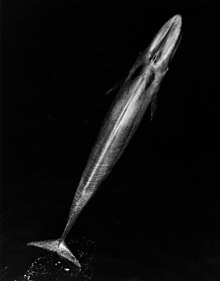



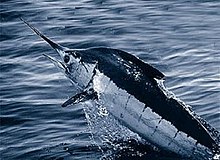

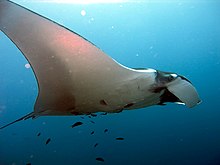




No comments:
Post a Comment